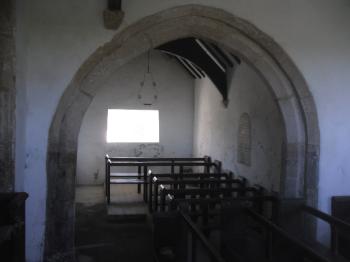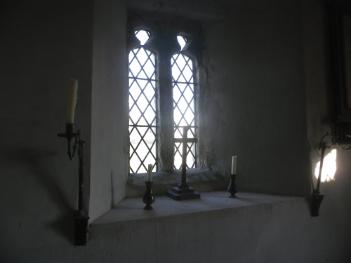LLANBEULAN CHURCH
Church of St Peulan, Gwalchmai

The Grade II listed 12th Century Llanbeulan Church of St Peulan rests in open countryside near Dothan and the A5 village of Gwalchmai on Anglesey.
Like many Anglesey churches its origin can be traced back as far as the early part of the 7th Century when Christianity made a very strong incursion into the spiritual and cultural life on the Island.
While staying on holiday Anglesey enjoying our Outanding Natural Beauty, do take the time to investigate our historic and spiritual past.
Sadly, Llanbeulan Church fell into decline and if it were not for the commitment and dedication of the Friends of Friendless Churches it may well have been closed and boarded up, like the church of St Peirio in the north of the Anglesey.
A walk around the overgrown church cemetery reveals that no-one has been laid to rest here in decades, if not half a century.
It is easier to imagine a coffin carried down to the church along the grass track by a horse drawn vehicle rather than a motorised hearse.
Make up your own mind when you visit.
Although now redundant, it has been saved by the Friends of Friendless Churches and offers visitors a unique lens into the past of the Anglesey’s rural communities.

TIME TO REFLECT ON TIME’S SWIFT ARROW
Before I launch into the history of this typical mediaeval Anglesey church may I respectfully you to take your time both inside and outside.
You will learn an enormous amount about the immediate area and its farms from the gravestones and will inevitably be moved by the brevity of a number of lives celebrated here.
Inside Llanbeulan Church there are fascinating memorials adhering to the walls and on one of the benches in the chancel.
Please do take a moment to reflect on the plain fact that these memorials were once brand new and a congregation would have gathered around to view them and talk about the deceased.

HISTORY OF LLANBEULAN CHURCH
LLANBEULAN CHURCH(LLAN-BEULAN), a parish partly in the hundred of LLYVON, partly in that of MALLTRAETH, and partly in that of TWRCELYN.
St Peulan is placed in history as a disciple of St Cybi, whose church is in Holyhead (Caergybi or Holy Island).
You enter the church through the 19th Century doorway and into the small South Chapel off the nave facing the pulpit.

This little chapel was added to the nave in the 14th Century and is separated from the nave by an arch, as is the chancel and its small chapel constructed during the same period.
You will notice a narrow vertical window beside the doorway which, it has been suggested, was placed here when the original church entrance at the end of the nave was blocked up and plastered over outside.

Where the old entrance used to be is now the church bell with a blessing and verse above and on either side.

HISTORICALLY UNIQUE FONT AT LLANBEULAN CHURCH
Take a few steps from the pulpit to end of the nave and glance down to your left. Here you will find the Font, which is very unique for a number of reasons.
Placed there on a rude plinth of stones it appears somewhat inappropriate. It is a grander object of antiquity than any other object or plaque of remembrance in llanbeulan Church.
The font as you may view in the image is of a different stone to any other you will find in or part of any other church on Anglesey.
The dimensions of this font are: 2 feet 1 inch (63.5 cm) by 2 feet 11 inches (88.9 cm) (external measurements) and is 11 inches (27.9 cm) deep. It is decorated on the front with a Celtic cross.

It has been dated to the 12th Century and is decorated on each of its sides. As above, there is a cross on the front and a chequered pattern at the back. While one of the longer sides is decorated with arches, the other has no pattern.
Intriguingly, the archaeologist David Petts proposes that this font probably had another purpose prior to that attributed to it today. Mr Petts is of the view that it is an object of antiquity attached to a wall in previous use and was not intended as a font.
Of course, this would explain why one side has no pattern – it was never meant to be viewed. So if it wasn’t originally a font, then what was it?
David Petts does not agree with the historian Peter Lord who believed that it was an altar dating back to the Norman Period when the church was first built of stone.
Mr Petts proposes that this object was not a font, nor an altar but a Reliquary. What’s a reliquary?
Actually it’s something with which you will be familiar: it is a container for religious relics. Such relics would be the clothing, bones or skulls of saints.
One of the greatest putative religious relics is the Turin Shroud.
The significance of some of these relics should never be underestimated. These reliquaries drew pilgrimages as great in their day as that of the modern day pilgrimages.

CHAPELS OF EASE
Standing in the open countryside of Llanbeulan it may be difficult for you to imagine that this was a very important church and a mother church for an area of Anglesey.
The church of St Peulan had two satellite Chapels of Ease, missionary chapels almost for those who could not travel regularly here. To the south you have the Chapel of Ease of St Mary Tal y Llyn and the Church of St Maelog in Llanfaelog near Rhosneigr.
I have written a page on St Mary Tal y Llyn and I invite you peruse it at your convenience.
These chapels of ease performed simple, regular religious services, marriages and christenings.
Below is an image of the Chapel of Ease at Lligwy were it was rare indeed for funerals to be conducted there. They would have been conducted at the main church of St Michael.

THE FRIENDS OF FRIENDLESS CHURCHES
The Friends were founded by Ivor Bulmer-Thomas in 1857 and exists to save churches and chapels of historic and architectural interest threatened by demolition or unseemly conversion.
Increasingly in recent years they have had to assume direct responsibility for such buildings and they now own by freehold or by lease, 46 former churches including 20 in Wales. All of these faced certain decay and demolition prior to the Friends’ intervention.
In addition to those churches which are directly held by the Friends, the organisation has been responsible for saving over a hundred more, many of which have subsequently been vested in the care of the Churches Conservation Trust established by Act of Parliament in 1969.

The Friends is an almost wholly voluntary organisation. It works in partnership with the Ancient Monuments Society with which it operates a joint membership scheme.
The Society is recognised as the equivalent in Wales of the Churches Conservation Trust and is thus paid 100% of the costs of taking outstanding Anglican churches in Wales into care.
Some of these churches are, of necessity, kept locked, but they may be visited by appointment and details of access can be provided.
Patron:
The Most Hon the Marquess of Anglesey F.S.A., D.Litt, F.R.Hist.S.
President:
The Most Hon the Marquess of Salisbury.
Contact:
St Ann’s Vestry Hall, 2 Church Entry, LONDON, EC4V 5HB
Tel: 0207 236 3934

GETTING TO LLANBEULAN CHURCH
View Llanbeulan Church of St Peulan in a larger map
Although it might feel rather difficult when you’re on the back road from the old Caer Glaw Farm, it really is quite straightforward to find your way to Llanbeulan Church.
My advice is that you start your journey in Gwalchmai rather than the other end. Let’s go.
- Pass the village shop/post office on your left and head out along the A5.
- Just out of the village you’ll pass the Hogan Quarry on your right. Onwards, ever onwards.
- No more than 300 metres past the quarry and below the brow of the hill you’ll see very old dilapidated farm buildings on your left and a road to your left. This is Caer Glaw after which the quarry is named - Take this turning.
- A couple of hundred metres ahead take the road to your right and follow it over the A55 Expressway and then turn left on the other side.
- Watch out for tractors. Less than half a mile along this narrow road you will see the church in the middle of fields on your right.
- Parking is a bit difficult. I just park at the gate opposite the farm, allowing plenty of space for agricultural traffic.
Return from Llanbeulan Church to the HOME PAGE.
Chapel of Ease of St Mary Tal y Llyn
Books by William Jones, author of
this web site.
Now in Paperback
.

LOVELY ANGLESEY WALKS & AMBLES
CLICK HERE

ANGLESEY'S AWARD
WINNING BEACHES
CLICK HERE
Recent Articles
-
North Stack Fog Warning Station. Beautiful Walk. Fascinating History
Dec 22, 23 12:35 PM
North Stack Fog Signal Station, just south of the Port of Holyhead, offers astonishing coastal walk and beautiful views of rugged Anglesey coastline. -
Holyhead Breakwater Country Park. Award Winning Anglesey Green Space
Dec 22, 23 12:31 PM
Holyhead Breakwater Country Park. Astonishing coastal beauty. Award Winning Anglesey Green Flag Country Park. A superb green space for family fun and walks -
White Beach. Excellent bleached pebble beach, Crazy Horses and Nervy Driving
Dec 08, 23 05:43 AM
White Beach really, really is a hidden gem. By that, I mean it is really, really well hidden. Dinner plate pebbles, nice picnics, CRAZY HORSES and some pretty good fishing.
Never EVER Stop Chasing Your Dreams.
ANGLESEY
MONOPOLY















New! Comments
Have your say about what you just read! Leave me a comment in the box below.